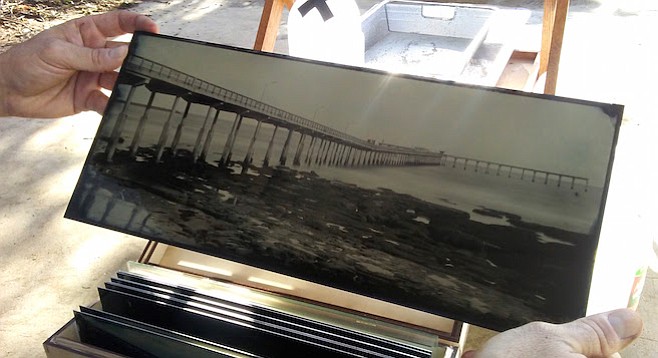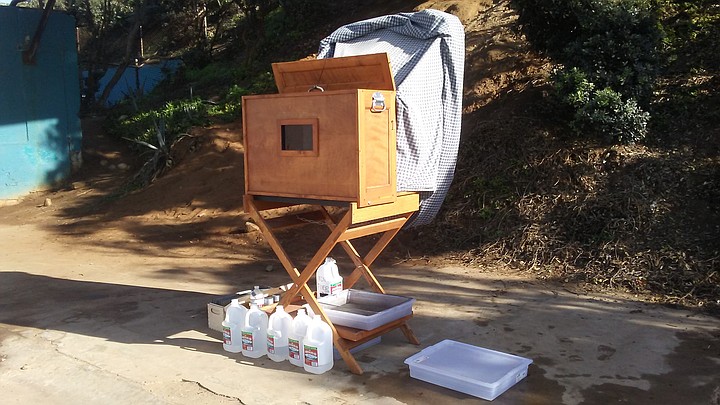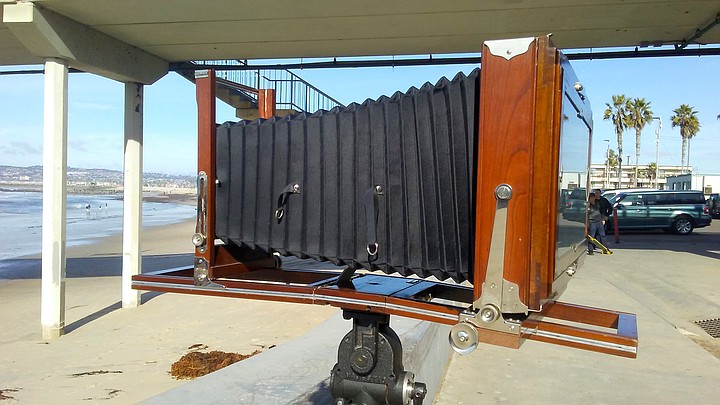 Facebook
Facebook
 X
X
 Instagram
Instagram
 TikTok
TikTok
 Youtube
Youtube

On Monday morning (December 12), Scott Basile was set up with an unusual camera to take photos of the pier in Ocean Beach.
“I was just about to pour another plate and get it rolling here,” he told me as I walked up to investigate.
“Take one of these,” he said, holding up what looked like a large chemistry slide. “Either metal or glass, this is what it starts as: this one is a piece of black metal — it has a little plastic coating on it to protect it, then I’ll peel this off and coat it with collodion,” he said, referring to a syrupy solution used in this original photographic process.
“Then it goes inside this tank which will be inside the darkroom, and that tank has silver nitrate in it which makes the plate light-sensitive. So then from there the plate goes inside this plate holder, which protects it from the light, the plate holder goes into the back of the camera….

"I expose the plate and then I come back here [the 'darkroom'] and develop it. So it all has to happen in about ten minutes before the chemistry dries; that’s why you have to have a darkroom with you when you shoot — everything has to happen immediately. By the time I pour the collodion on the plate, I’ve got maybe ten minutes to make a picture."
How did Basile become interested in tintype photography?
“I make my living as a commercial photographer. I shoot digital and was kind of getting bored sitting in front of a computer all the time, so I started doing research on different photographic processes that led me to this. It’s a long prep process, too; I’ll be here for a few hours and might end up with four pictures.”
There are different sized cameras and plates, so the size of the camera dictates the size of plate you use. On this day he was using a panoramic camera.
The results are beautiful images that have a vintage look.

“That’s because that’s how they made them in the 1850s — everything is the same: same chemistry, same process, everything from 1851, literally.”
Where does one find a working camera from the 1850s and the portable darkroom?
“There’s a guy in New York who makes these portable darkrooms so I had him make one of these for me. And the camera, lenses, and stuff like that, just wherever I can scrounge it. Sometimes you get lucky. My parents are retired and they’re into antiquing, so I’ve got them trained. You’d be surprised; they scored me a killer 11˝x14˝ 120-year-old camera for really cheap because sometimes people don’t know what they have. There’s not a lot of these cameras around anymore, so finding old ones in working order is difficult.”
See Basile's work at blackarttintype.com.


On Monday morning (December 12), Scott Basile was set up with an unusual camera to take photos of the pier in Ocean Beach.
“I was just about to pour another plate and get it rolling here,” he told me as I walked up to investigate.
“Take one of these,” he said, holding up what looked like a large chemistry slide. “Either metal or glass, this is what it starts as: this one is a piece of black metal — it has a little plastic coating on it to protect it, then I’ll peel this off and coat it with collodion,” he said, referring to a syrupy solution used in this original photographic process.
“Then it goes inside this tank which will be inside the darkroom, and that tank has silver nitrate in it which makes the plate light-sensitive. So then from there the plate goes inside this plate holder, which protects it from the light, the plate holder goes into the back of the camera….

"I expose the plate and then I come back here [the 'darkroom'] and develop it. So it all has to happen in about ten minutes before the chemistry dries; that’s why you have to have a darkroom with you when you shoot — everything has to happen immediately. By the time I pour the collodion on the plate, I’ve got maybe ten minutes to make a picture."
How did Basile become interested in tintype photography?
“I make my living as a commercial photographer. I shoot digital and was kind of getting bored sitting in front of a computer all the time, so I started doing research on different photographic processes that led me to this. It’s a long prep process, too; I’ll be here for a few hours and might end up with four pictures.”
There are different sized cameras and plates, so the size of the camera dictates the size of plate you use. On this day he was using a panoramic camera.
The results are beautiful images that have a vintage look.

“That’s because that’s how they made them in the 1850s — everything is the same: same chemistry, same process, everything from 1851, literally.”
Where does one find a working camera from the 1850s and the portable darkroom?
“There’s a guy in New York who makes these portable darkrooms so I had him make one of these for me. And the camera, lenses, and stuff like that, just wherever I can scrounge it. Sometimes you get lucky. My parents are retired and they’re into antiquing, so I’ve got them trained. You’d be surprised; they scored me a killer 11˝x14˝ 120-year-old camera for really cheap because sometimes people don’t know what they have. There’s not a lot of these cameras around anymore, so finding old ones in working order is difficult.”
See Basile's work at blackarttintype.com.
Comments